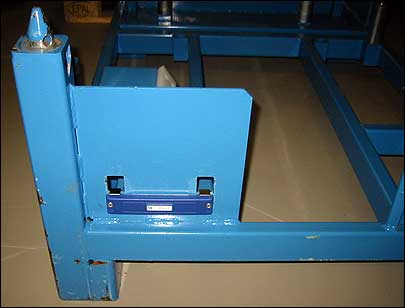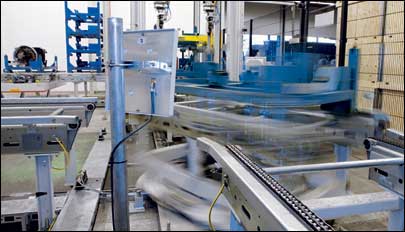ZF Friedrichshafen, a German supplier of transmissions and chassis components to major vehicle manufacturers worldwide, has implemented a radio frequency identification-based container management system as part of its facility upgrades. The RFID application improves the shipping process by reducing the time required for handling containers. Now the company is performing tests to determine which other processes may be improved via RFID.
ZF maintains 119 plants in 25 countries and employs approximately 57,000 people. In 2007, reported revenues were €12.65 billion ($19.5 billion). At its plant in Friedrichshafen, near Germany’s Lake Constance, the company manufactures transmissions and drivelines for commercial vehicles made by MAN and Iveco, among others.
Truck makers increasingly demand not only “just-in-time” shipping but also “just-in-sequence,” and ZF wanted to improve its processes to be able to ship the correct goods at the right time in the proper sequence. ZF saw an article in a trade magazine regarding an RFID system implemented by Tricon, an Austrian RFID systems integrator, and contacted the company.
The RFID system Tricon set up in late 2006 employs 15,000 to 20,000 passive ultrahigh-frequency (UHF) tags and tracks 1,000 container movements per day, and has been running without problems since it went live at the end of 2006. The company has discussed rolling out the system at other plants, says Jürgen Kusper, Tricon’s project manager, but no decision has yet been made.
The system has provided ZF with a more accurate inventory of its containers than in the past. Before RFID was implemented, the company counted containers manually on specific days to determine average inventories. In addition, Kusper says, RFID has helped ZF minimize the loss of costly containers, though he is unable at this time to provide further details about annual losses or the price the company pays for the containers. “Now,” he states, “the company knows which containers have been returned from its customers and which containers are available for shipments.”
When containers are returned by truck and bus makers, they are typically stacked in a temporary holding area. A few days later, workers place the containers on a conveyor system that automatically moves them to a completely automated high-rack storage area. As a container moves along a track, an RFID reader made by FEIG Electronic is used to identify it. Based on tag location during reading, the system can determine if a container is in the correct position on the track, or if it must be rotated 180 degrees.
This is the single RFID read point in the entire application, except when new containers are introduced into the flow. Since containers are moved automatically throughout the process of filling and preparing orders for shipment, the computer system can calculate a container’s location at subsequent points, based on the single identification. When new containers are added to the mix, employees initialize them using one of three handheld interrogators made by TDS Recon. The system assigns a container number to each tag, and that number plus a description of the carrier are encoded onto the tag, enabling ZF to track which containers went to which customers. Workers choose from an option menu to describe the container after visual identification. ZF uses nine types of containers.
Workers who need to assemble a drive or part place an electronic order via the company’s warehouse management system. The automatic system places the components in a tagged steel container—which can vary in size from 80 by120 centimeters (32 by 47 inches) to 80 by 160 centimeters(32 by 63 inches)— and moves the container to the proper position in the production area. Automation helps speed production and delivery, and is necessary because parts can be too heavy for workers to lift. As soon as the container’s tag is identified upon its return—that is, once it is moved to the conveyor—the system is updated, allowing ZF to create a report about which containers are with which customers at that particular time.
ZF is considering changing the RFID system so the tag is interrogated automatically as soon as a customer returns a container to ZF’s warehouse, rather than waiting for the container to pass an RFID reader along the conveyor track after spending a few days in the interim holding area. Interrogation would occur when the containers pass through an automated portal. Reading the tags earlier would afford the company a greater overview of the containers available.
During the first phase of the project, Tricon chronicled ZF’s processes and tested RFID hardware before making a recommendation about the design of the RFID system. The biggest challenge Tricon faced was finding the right transponders to identify the containers, given the metallic and mechanical environment. The tags needed to provide a long read range—even when fixed to a metal surface—fit well on a container, and be easy to attach and cost-effective, given the application’s high volumes. Tricon ultimately opted to use tags from Intermec that operate at 869 MHz and comply with the ISO 18000-6B standard.




